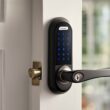Sliding doors operate by gliding horizontally on tracks with rollers distributing their weight evenly to guarantee smooth function. Understanding load types—static and dynamic—helps you select materials and hardware that support the door’s weight without causing excessive friction or wear. Regular maintenance, like cleaning tracks with mild soap, inspecting hardware, and lubricating moving parts, extends the door’s lifespan and prevents malfunction. Proper track alignment is essential to maintain performance and avoid damage. Exploring these basics will deepen your knowledge of effective sliding door design and care.
How Sliding Doors Operate
Although sliding doors may seem simple, their operation relies on a precise mechanism that allows smooth horizontal movement.
You’ll find that door mechanics involve components such as rollers and guides working together to guarantee stability and ease. Central to this system are track systems, which provide the path along which the door glides.
These tracks need to be properly aligned and maintained to prevent friction and wear. When you slide the door, the rollers move within the track, distributing weight evenly and allowing effortless motion.
Understanding these basic mechanics helps you appreciate how sliding doors function efficiently in various settings.
Understanding Load Types on Sliding Doors
The smooth movement of sliding doors depends heavily on how they handle different types of loads. You need to take into account both static and dynamic loads when designing or installing a sliding door.
Load distribution plays an essential role in ensuring that the door operates smoothly without undue stress on any component. Weight considerations affect the choice of materials and hardware, as heavier doors require stronger tracks and rollers.
Properly balancing these factors helps prevent premature wear and maintains functionality. Understanding these load types allows you to select appropriate designs that support efficient, long-lasting sliding door operation.
Tips for Maintaining Sliding Doors Over Time
Since sliding doors experience frequent use and exposure to various environmental factors, maintaining them regularly is essential to guarantee peak performance and longevity.
Start by applying proper cleaning techniques, such as using mild soap and water to remove dirt and debris without damaging the surfaces. Avoid harsh chemicals that can degrade materials over time.
Next, perform routine hardware inspection to identify loose screws, worn rollers, or damaged tracks. Lubricate moving parts with appropriate products to assure smooth operation.
Addressing these maintenance tasks promptly helps prevent costly repairs, extends the door’s lifespan, and maintains safety and functionality throughout its service life.
Frequently Asked Questions
What Materials Are Best for Sliding Door Frames?
You’ll find aluminum frames popular for their strength and low maintenance, while vinyl frames offer good insulation and affordability.
Wood frames provide natural beauty and excellent insulation but require more upkeep.
Fiberglass frames combine durability and low maintenance with better thermal performance.
Your choice depends on factors like climate, budget, and aesthetic preferences, so weigh these materials’ benefits carefully to select the best fit for your sliding door frame.
How Do Sliding Doors Compare in Energy Efficiency to Hinged Doors?
Sliding doors typically have higher energy loss than hinged doors due to larger glass areas and sliding mechanisms that can create small gaps.
However, their thermal performance depends on quality seals and frame materials. You can improve this by selecting well-insulated frames and weatherstripping.
Hinged doors often offer a tighter seal, reducing drafts and enhancing energy efficiency.
Still, with proper design, sliding doors can perform comparably in minimizing energy loss.
Can Sliding Doors Be Customized for Security Features?
Yes, sliding doors can be customized with various security enhancements to improve safety.
You can choose advanced locking mechanisms, such as multi-point locks or keyed locks, which provide stronger resistance against forced entry.
Additionally, security bars and reinforced glass options are available to further protect your sliding door.
These features allow you to tailor your door’s security level according to your needs, ensuring both convenience and reliable protection for your property.
What Are the Common Styles of Sliding Doors Available?
You’ll find common sliding door styles include modern aesthetics, featuring sleek frames and large glass panels, ideal for contemporary spaces.
Traditional designs often use wood or wood-look materials with divided glass panes, offering a classic feel.
Additionally, you can choose from frameless glass doors for a minimalist look or multi-panel sliding doors that maximize opening space.
Each style balances functionality with visual appeal, fitting different architectural preferences and practical needs.
Are Sliding Doors Suitable for All Climate Conditions?
Sliding doors can be suitable for many climate conditions, but you need to take into account weather considerations carefully.
Their climate adaptability depends on factors like insulation quality, frame material, and sealing effectiveness.
In harsh climates with extreme temperatures or heavy moisture, you should choose sliding doors designed to withstand those conditions to prevent drafts, water intrusion, or damage.
Proper maintenance also supports long-term performance, ensuring the doors function well despite varied weather challenges.








